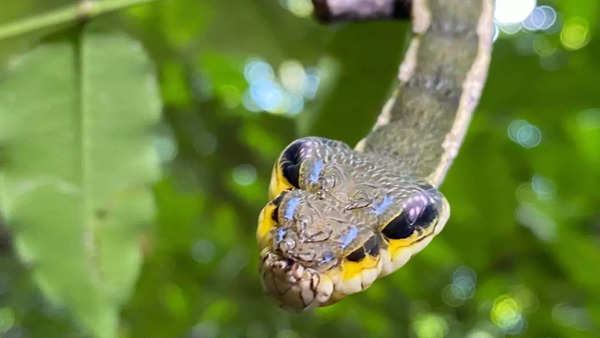This defensive tactic is particularly notable in the hawk moth’s larvae. When danger looms, the caterpillar contorts its body and puffs up its thorax to reveal a pattern that mimics the eyes of a snake. This visual deception is so effective that it can deter not only avian predators but also unsuspecting humans. The sphinx moth caterpillar’s mimicry is a classic example of Batesian mimicry, a survival strategy where a harmless species imitates the warning signals of a harmful one to evade predators.
Watch the video here:
The discovery of this mimicry was first documented in the lush forests of Missouri, where over 50 species of sphinx moths have been identified. These caterpillars are known to feed on a variety of host plants, and their adult counterparts are recognized for their rapid and agile flight, reaching speeds of over 30 miles per hour. The adult sphinx moths are also known for their long proboscis, which they use to draw nectar from deep, tubular flowers.

The phenomenon of the caterpillar’s transformation was first observed in the forests of Missouri. Source: @Bernadotte22/X
The life cycle of the sphinx moth caterpillar is a journey of transformation. After emerging from eggs, the caterpillars go through several instars, shedding their skin multiple times as they grow. Once they reach maturity, they enter the pupation stage, eventually emerging as adult moths. This cycle of growth and change is emblematic of the adaptability and resilience of these creatures.
The sphinx moth caterpillar’s snake-mimicking behavior is not its only defense mechanism. Some species, like the walnut sphinx caterpillar, can produce a whistling hiss by forcing air out of their spiracles when disturbed. This sound, along with the visual threat display, provides a multi-sensory deterrent to potential threats.
The presence of the sphinx moth caterpillar across various regions, including North America, underscores the ecological significance of these organisms. They play a vital role in the pollination of many plant species and serve as a food source for other wildlife. The sphinx moth caterpillar’s ability to mimic a snake is a fascinating example of nature’s ingenuity and serves as a reminder of the intricate balance within ecosystems.
As researchers continue to study the sphinx moth caterpillar, they gain insights into the complex interactions between species and the importance of each organism in maintaining biodiversity. The sphinx moth caterpillar, with its unique defense mechanism, is just one of the many marvels of the natural world that highlight the importance of conservation and the need to protect our planet’s delicate ecosystems.
Life continues to thrive in Pallikaranai

